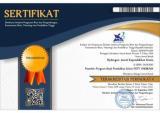Determination of Total Tannin Content from Methanol Extracts of Various Species of Ferns (Pteridophyta)
Abstract
Abstract
The use of heavy-metal mordants in fabric dyeing is prohibited due to the resulting impacts such as environmental damage and public health, therefore environmentally friendly and non-toxic mordants such as tannin mordants (biomordants) are needed. Based on phytochemical screening on fern species (Pteridophyta), it is known that they contain tannins. However, scientific evidence of determining the total tannin content of various species of ferns has so far not been found. This study aims to determine the yield and total tannin content of methanol extracts of five fern species, namely paku kawat (Lycopodium cernuum), paku resam (Gleichenia linearis), paku dayak (Blechnum orientale), paku uban (Nephrolepis biserrata), paku miding (Stenochlaena palustris). Sample extraction was carried out by maceration method using methanol solvent. Extract yield was determined by weighing method. Analysis of total tannin content was carried out by UV-Vis spectrophotometric method at a wavelength of 755.8 nm using Folin-Ciocalteu reagent and sodium carbonate. The results of the research obtained the yield of methanol extracts on paku kawat, paku resam, paku dayak, paku uban, and paku miding are 11.271%; 8.389%; 4.810%; 3.615%; and 0.854%, respectively. Total tannin levels in methanol extracts of paku kawat, paku resam, paku dayak, paku uban, and paku miding were 0.024% ± 0.002; 0.256% ± 0.029; 0.272% ± 0.037; 0.143% ± 0.019; and 0.022% ± 0.012, respectively. Based on these data, it can be concluded that the methanol extract of paku kawat produces the highest yield while paku dayak produce the highest total tannin content. The results indicate that differences in fern species cause differences in tannin levels.
Full Text:
PDFReferences
Abdurahman, S. N., & Kahdar, K. (2021). Eksplorasi Ekstrak Pewarna Alami sebagai Bahan Pewarna Organik untuk Tekstil Cetak. Jurnal Rupa, 6(2), 134–145. https://doi.org/10.25124/rupa.v6i2.3792
Adu, R. E. Y., Tea, M. T. D., & Bouk, Y. (2022). Ekstraksi Tanin dari Limbah Kulit Biji Asam dan Penggunaannya sebagai Biomordan pada Pewarnaan Tenun Timor Secara Alami. Jurnal Riset Kimia, 13(2), 178–187. https://doi.org/10.25077/jrk.v13i2.509
Anal, J. M. H., & Chase, P. (2016). Trace Elements Analysis in Some Medicinal Plants Using Graphite Furnace-Atomic Absorption Spectroscopy. Environmental Engineering Research, 21(3), 247–255. https://doi.org/10.4491/eer.2016.007
Andriyani, D., Utami, P. I., & Dhiani, B. A. (2010). Penetapan Kadar Tanin Daun Rambutan (Nephelium lappaceum.L ) Secara Spektrofotometri Ultraviolet Visibel. PHARMACY, 07(02), 1–11.
Chakraborty, J. N. (2010). Fundamentals and Practices in Colouration of Textiles. New Delhi: Woodhead Publishing India.
Chintya, N., & Utami, B. (2017). Ekstraksi Tannin dari Daun Sirsak (Annona muricata L.) sebagai Pewarna Alami Tekstil. JC-T (Journal Cis-Trans): Jurnal Kimia Dan Terapannya, 1(1), 22–29. https://doi.org/10.17977/um026v1i12017p022
Farida, F., Atika, V., & Haerudin, A. (2015). Pengaruh Variasi Bahan Pra Mordan pada Pewarnaan Batik Menggunakan Akar Mengkudu (Morinda citrifolia). Dinamika Kerajinan Dan Batik: Majalah Ilmiah, 32(1), 1–8. https://doi.org/10.22322/dkb.v32i1.1164
Fatonah, R., Mulyaningsih, S., & Ardiana, C. (2021). Penentuan Kadar Total Tanin dari Ekstrak Daun Binahong (Anredera cordifolia). Jurnal Life Science, 3(1), 38–46. https://doi.org/10.31980/jls.v3i2.1670
Firyanto, R. (2022). Pemanfaatan Kulit Kayu Mahoni Sebagai Pewarna Alami Kain Batik di Kelurahan Meteseh Kecamatan Tembalang Kota Semarang. Jurnal Abdi Masyarakat Indonesia (JAMSI), 2(2), 487–494. https://doi.org/10.54082/jamsi.262
Habibi, A. I., Firmansyah, R. A., & Setyawati, S. M. (2018). Skrining Fitokimia Ekstrak n-Heksan Korteks Batang Salam (Syzygium polyanthum). Indonesian Journal of Chemical Science, 7(1), 1–4.
Haryati, N. A., Saleh, C., & Erwin. (2015). Uji Toksisitas dan Aktivitas Antibakteri Ekstrak Daun Merah Tanaman Pucuk Merah Terhadap Bakteri Staphylococus aureus dan Eschericia coli. Jurnal Kimia Mulawarman, 13(1), 35–40.
Hikmah, A. R., & Retnasari, D. (2021). Ecoprint Sebagai Alternatif Peluang Usaha Fashion yang Ramah Lingkungan. Prosiding Pendidikan Teknik Boga Busana, 16(1), 1–5.
Indarto, I., Narulita, W., Anggoro, B. S., & Novitasari, A. (2019). Aktivitas Antibakteri Ekstrak Daun Binahong Terhadap Propionibacterium acnes. Biosfer: Jurnal Tadris Biologi, 10(1), 67–78. https://doi.org/10.24042/biosfer.v10i1.4102
Kurniasari, I. D., & Maharani, D. K. (2015). Pembuatan Komposit Kitosan Alumina Sebagai Agen Fiksasi Zat Warna Rodamin B Pada Kain Katun. UNESA Journal of Chemistry, 4(1), 75–80.
Lai, H. Y., Lim, Y. Y., & Kim, K. H. (2010). Blechnum Orientale Linn - a Fern with Potential As Antioxidant, Anticancer and Antibacterial Agent. BMC Complementary and Alternative Medicine, 10(15), 1–8. https://doi.org/10.1186/1472-6882-10-15
Lestari, D. W., Atika, V., Satria, Y., Fitriani, A., & Susanto, T. (2020). Aplikasi Mordan Tanin pada Pewarnaan Kain Batik Katun Menggunakan Warna Alam Tingi (Ceriops tagal). Jurnal Rekayasa Proses, 14(2), 128–136. https://doi.org/10.22146/jrekpros.57891
Lestariningsih, S. P., Riyono, J. N., & Siswoyo, A. (2021). Pemanfaatan Pakis Sebagai Motif Alami pada Kain (Ecoprint) untuk Pengembangan Ekonomi Kreatif Di Desa Rasau Jaya Umum, Kabupaten Kubu Raya. Prosiding SNAPP : Sosial Humaniora, Pertanian, Kesehatan Dan Teknologi, 1(1), 518–526.
Listiana, L., Wahlanto, P., Ramadhani, S. S., & Ismail, R. (2022). Penetapan Kadar Tanin dalam Daun Mangkokan (Nothopanax scutellarium Merr) Perasan dan Rebusan dengan Spektrofotometer UV-Vis. Pharmacy Genius, 1(1), 62–73. https://doi.org/10.56359/pharmgen.v1i01.152
Mahmudah, R., & Achir, S. (2013). Pengaruh Jenis Mordan Terhadap Hasil Pewarnaan Alami Ranting Pohon Mangga untuk Pewarnaan Batik pada Rok. Jurnal Online Tata Busana, 02(01), 82–86.
Manongko, P. S., Sangi, M. S., & Momuat, L. I. (2020). Uji Senyawa Fitokimia dan Aktivitas Antioksidan Tanaman Patah Tulang (Euphorbia tirucalli L.). Jurnal MIPA, 9(2), 64–69. https://doi.org/10.35799/jmuo.9.2.2020.28725
Marliana, S. D., Suryanti, V., & Suyono. (2005). Skrining Fitokimia dan Analisis Kromatografi Lapis Tipis Komponen Kimia Buah Labu Siam (Sechium edule Jacq. Swartz.) dalam Ekstrak Etanol. Biofarmasi, 3(1), 26–31.
Masriani, M., Muharini, R., Wijayanti, D. K., Melanie, P., & Sari, M. L. W. (2023). Phytochemical Screening of Ethanol Extracts from Three Variants of Kratom Leaves (Mitragyna speciosa Korth.). Hydrogen: Jurnal Kependidikan Kimia, 11(2), 192–201. https://e-journal.undikma.ac.id/index.php/hydrogen/article/view/7122
Meigaria, K. M., Mudianta, I. W., & Martiningsih, N. W. (2016). Skrining Fitokimia dan Uji Aktivitas Antioksidan Ekstrak Aseton Daun Kelor (Moringa oleifera). Jurnal Wahana Matematika Dan Sains, 10(2), 1–11.
Mulyani, E., Herlina, H., & Suci, K. (2022). Penetapan Kadar Tanin Ekstrak Daun Pagoda (Clerodendrum Paniculantum) dengan Metode Spektrofotometri Visible dan Titrasi Permanganometri. Lumbung Farmasi: Jurnal Ilmu Kefarmasian, 3(1), 7–11. https://doi.org/10.31764/lf.v3i1.7034
Nahor, E. M., Rumagit, B. I., & YTou, H. (2020). Perbandingan Rendemen Ekstrak Etanol Daun Andong (Cordyline futicosa L.) Menggunakan Metode Ekstraksi Maserasi dan Sokhletasi. Jurnal Poltekkes Manado, 1(1), 40–44.
Noviyanty, Y., Hepiyansori, & Agustian, Y. (2020). Identifikasi dan Penetapan Kadar Senyawa Tanin pada Ekstrak Daun Biduri (Calotropis gigantea) Metode Spektrofotometri UV-Vis. Jurnal Ilmiah Manuntung, 6(1), 57–64.
Permatasari, K. A. N., & Lestari, N. P. E. B. (2023). Pemanfaatan Pewarna Alam dalam Menghasilkan Karya Fesyen (Studi Kasus Produk Busana Casual Pria Dan Wanita). Jurnal Da Moda, 4(2), 53–64. https://jurnal.std-bali.ac.id/index.php/damoda
Prananda, Y., Riza, H., Fajriaty, I., Nasrullah, N., & Hasibuan, V. M. (2015). Skrining Fitokimia Ekstrak Etanol Daun Simpur (Dillenia indica L.) Sebagai Tahapan Awal pada Pengujian Toksistas. Jurnal Untan, 3(1), 1–13.
Pratama, M., Razak, R., & Rosalina, V. S. (2019). Analisis Kadar Tanin Total Ekstrak Etanol Bunga Cengkeh (Syzygium aromaticum L.) Menggunakan Metode Spektrofotometri UV-Vis. Jurnal Fitofarmaka Indonesia, 6(2), 368–373. https://doi.org/10.33096/jffi.v6i2.510
Purwati, P., Harningsih, T., & Saroh, D. (2023). Gambaran Kadar Timbal pada Pekerja Pewarna Batik di Laweyan. Jurnal Farmasetis, 12(2), 179–186. https://doi.org/10.32583/far.v12i2.1090
Rahayu, S., Kurniasih, N., & Amalia, V. (2015). Ekstraksi dan Identifikasi Senyawa Flavonoid dari Limbah Kulit Bawang Merah Sebagai Antioksidan Alami. Al Kimiya, 2(1), 1–8.
Reiza, I. A., Rijai, L., & Mahmudah, F. (2019). Skrining Fitokimia Ekstrak Etanol Kulit Nanas (Ananas comosus (L.) Merr). Proceeding of Mulawarman Pharmaceuticals Conferences, 10, 104–108. https://doi.org/10.25026/mpc.v10i1.371
Sari, A. K., Ayuchecaria, N., Febrianti, D. R., Alfiannor, M. M., & Regitasari, V. (2019). Analisis Kuantitatif Kadar Flavonoid Ekstrak Etanol Daun Belimbing Wuluh (Averrhoa bilimbi l.) di Banjarmasin dengan Metode Spektrofotometri UV-Visible. Jurnal Insan Farmasi Indonesia, 2(1), 7–17. https://doi.org/10.36387/jifi.v2i1.315
Saxena, S., & Raja, A. S. M. (2014). Natural dyes: sources, chemistry, application and sustainability issues. In Roadmap to susttainable textiles and clothing (pp. 37–80). https://doi.org/10.1007/978-981-287-065-0_4
Shah, M. D., Yong, Y. S., & Iqbal, M. (2014). Phytochemical Investigation and Free Radical Scavenging Activities of Essential Oil, Methanol Extract and Methanol Fractions of Nephrolepis biserrata. International Journal of Pharmacy and Pharmaceutical Sciences, 6(9), 269–277.
Shaikh, J. R., & Patil, M. K. (2020). Qualitative Tests for Preliminary Phytochemical Screening: an Overview. International Journal of Chemical Studies, 8(2), 603–608. https://doi.org/10.22271/chemi.2020.v8.i2i.8834
Siva, R. (2007). Status of Natural Dyes and Dye-Yielding Plants in India. Current Science, 92(7), 916–925.
Sugiyono. (2019). Metode Penelitian Kuantitatif, Kualitatif, dan R&D. Bandung: Alphabet
Sulasmi, E. S., Sari, R. S., Sari, M. S., & Suhadi, S. (2018). Skrining Fitokimia dan Uji Kromatografi Lapis Tipis Kandungan Senyawa Flavonoid dari 5 Spesies Daun Tumbuhan Paku di Taman Nasional Baluran. Prosiding Seminar Nasional VI Hayati, September, 115–120.
Sulistyarini, I., Sari, D. A., & Wicaksono, T. A. (2020). Skrining Fitokimia Senyawa Metabolit Sekunder Batang Buah Naga (Hylocereus polyrhizus). Jurnal Ilmiah Cendekia Eksakta, 5(1), 56–62.
Sumarli, S. (2021). Penerapan Pewarna Alami Biji Alpukat pada Kain Katun. ORBITA: Jurnal Kajian, Inovasi Dan Aplikasi Pendidikan Fisika, 7(2), 400–405. https://doi.org/10.31764/orbita.v7i2.5543
Swandi, M. K., & Salmi, S. (2023). Ekstrak Daun Paku Resam (Gleichenia linearis (Burm.) C.B. Clarke) Berpotensi Sebagai Tanaman Obat Berdasarkan Profil Fitokimia dan Kadar Total Fenol. BERKALA SAINSTEK, 11(2), 96–105. https://doi.org/10.19184/bst.v11i2.34875
Syamsudin, S., Alimuddin, A. H., & Sitorus, B. (2022). Isolasi dan Karakterisasi Senyawa Fenolik dari Daun Putat (Planchonia valida Blume). Indonesian Journal of Pure and Applied Chemistry, 5(2), 85.
Ulum, F. B., & Setyati, D. (2015). Ephypitic Ferns (Pteridophyta) from Raung Mount Banyuwangi, East Java Indonesia. Jurnal ILMU DASAR, 16(1), 7–12. https://doi.org/10.19184/jid.v16i1.1486
Wibawa, A. A. C. (2021). Kapasitas Total Antioksidan Ekstrak Metanol Biji Kakao (Theobroma cacao. L) dengan Metode Spektrofotometri UV-Vis. Hydrogen: Jurnal Kependidikan Kimia, 9(1), 30–37. https://doi.org/10.33394/hjkk.v9i1.3794
Yernisa, Y., Gumbira-Sa’id, E., & Khaswar, S. (2013). Aplikasi Pewarna Bubuk Alami dari Ekstrak Biji Pinang (Area catechu L.) pada Pewarnaan Sabun Transparan. Jurnal Teknologi Industri Pertanian, 23(3), 190–198.
DOI: https://doi.org/10.33394/hjkk.v12i2.11597
Refbacks
- There are currently no refbacks.

This work is licensed under a Creative Commons Attribution-ShareAlike 4.0 International License.





